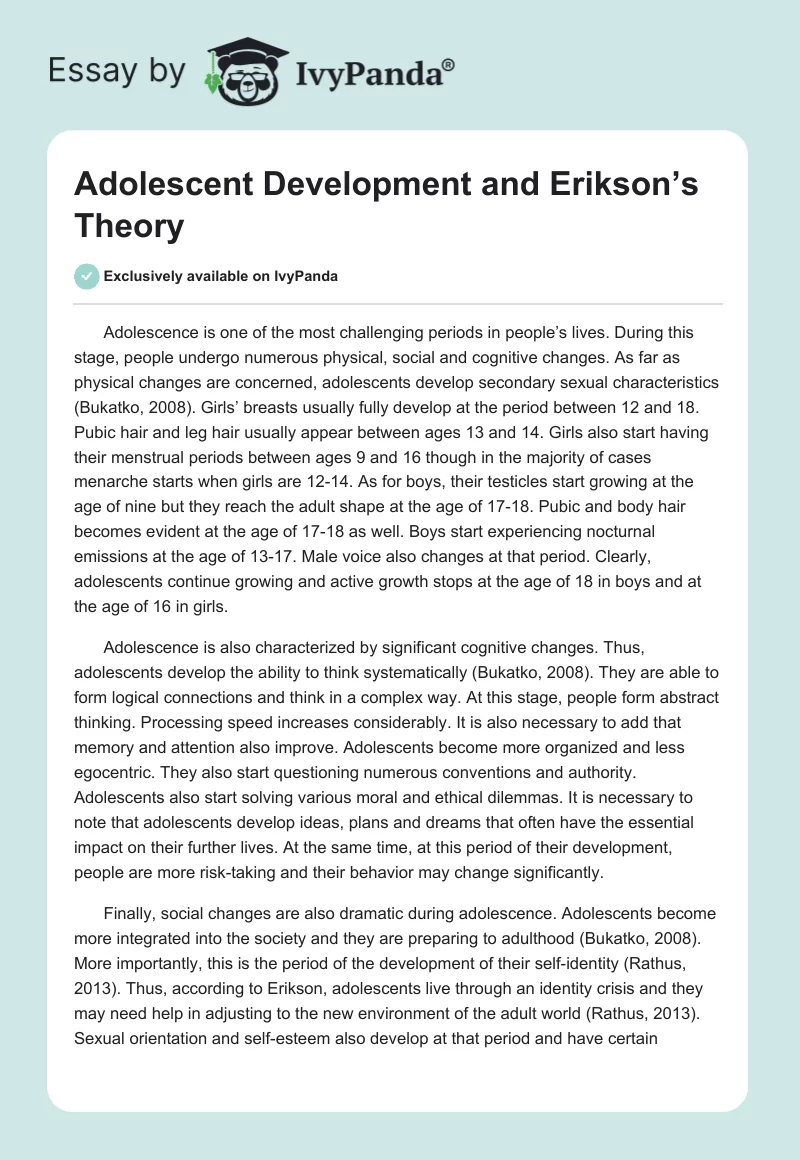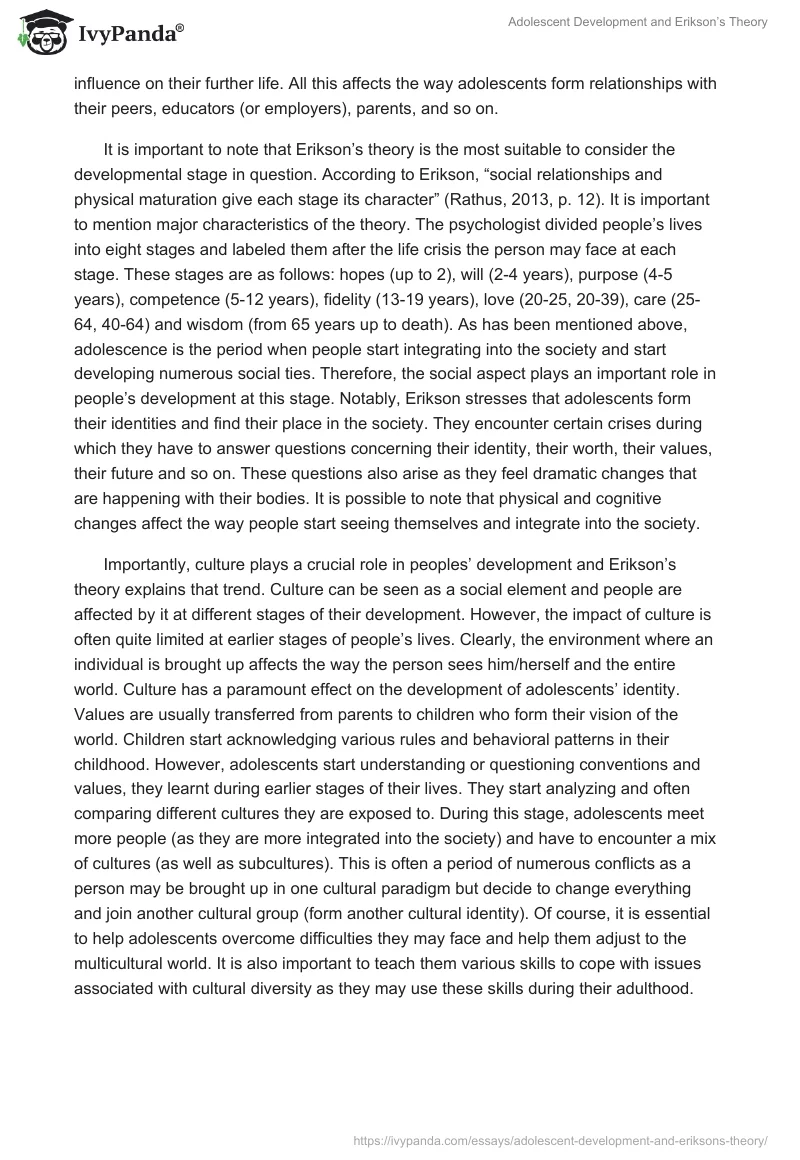Adolescence is one of the most challenging periods in people’s lives. During this stage, people undergo numerous physical, social and cognitive changes. As far as physical changes are concerned, adolescents develop secondary sexual characteristics (Bukatko, 2008). Girls’ breasts usually fully develop at the period between 12 and 18. Pubic hair and leg hair usually appear between ages 13 and 14. Girls also start having their menstrual periods between ages 9 and 16 though in the majority of cases menarche starts when girls are 12-14. As for boys, their testicles start growing at the age of nine but they reach the adult shape at the age of 17-18. Pubic and body hair becomes evident at the age of 17-18 as well. Boys start experiencing nocturnal emissions at the age of 13-17. Male voice also changes at that period. Clearly, adolescents continue growing and active growth stops at the age of 18 in boys and at the age of 16 in girls.
Adolescence is also characterized by significant cognitive changes. Thus, adolescents develop the ability to think systematically (Bukatko, 2008). They are able to form logical connections and think in a complex way. At this stage, people form abstract thinking. Processing speed increases considerably. It is also necessary to add that memory and attention also improve. Adolescents become more organized and less egocentric. They also start questioning numerous conventions and authority. Adolescents also start solving various moral and ethical dilemmas. It is necessary to note that adolescents develop ideas, plans and dreams that often have the essential impact on their further lives. At the same time, at this period of their development, people are more risk-taking and their behavior may change significantly.
Finally, social changes are also dramatic during adolescence. Adolescents become more integrated into the society and they are preparing to adulthood (Bukatko, 2008). More importantly, this is the period of the development of their self-identity (Rathus, 2013). Thus, according to Erikson, adolescents live through an identity crisis and they may need help in adjusting to the new environment of the adult world (Rathus, 2013). Sexual orientation and self-esteem also develop at that period and have certain influence on their further life. All this affects the way adolescents form relationships with their peers, educators (or employers), parents, and so on.
It is important to note that Erikson’s theory is the most suitable to consider the developmental stage in question. According to Erikson, “social relationships and physical maturation give each stage its character” (Rathus, 2013, p. 12). It is important to mention major characteristics of the theory. The psychologist divided people’s lives into eight stages and labeled them after the life crisis the person may face at each stage. These stages are as follows: hopes (up to 2), will (2-4 years), purpose (4-5 years), competence (5-12 years), fidelity (13-19 years), love (20-25, 20-39), care (25-64, 40-64) and wisdom (from 65 years up to death). As has been mentioned above, adolescence is the period when people start integrating into the society and start developing numerous social ties. Therefore, the social aspect plays an important role in people’s development at this stage. Notably, Erikson stresses that adolescents form their identities and find their place in the society. They encounter certain crises during which they have to answer questions concerning their identity, their worth, their values, their future and so on. These questions also arise as they feel dramatic changes that are happening with their bodies. It is possible to note that physical and cognitive changes affect the way people start seeing themselves and integrate into the society.
Importantly, culture plays a crucial role in peoples’ development and Erikson’s theory explains that trend. Culture can be seen as a social element and people are affected by it at different stages of their development. However, the impact of culture is often quite limited at earlier stages of people’s lives. Clearly, the environment where an individual is brought up affects the way the person sees him/herself and the entire world. Culture has a paramount effect on the development of adolescents’ identity. Values are usually transferred from parents to children who form their vision of the world. Children start acknowledging various rules and behavioral patterns in their childhood. However, adolescents start understanding or questioning conventions and values, they learnt during earlier stages of their lives. They start analyzing and often comparing different cultures they are exposed to. During this stage, adolescents meet more people (as they are more integrated into the society) and have to encounter a mix of cultures (as well as subcultures). This is often a period of numerous conflicts as a person may be brought up in one cultural paradigm but decide to change everything and join another cultural group (form another cultural identity). Of course, it is essential to help adolescents overcome difficulties they may face and help them adjust to the multicultural world. It is also important to teach them various skills to cope with issues associated with cultural diversity as they may use these skills during their adulthood.
Reference List
Bukatko, D. (2008). Child and adolescent development: A chronological approach. Boston, MA: Houghton Mifflin Co.
Rathus, S. (2013). Child and adolescence: Voyages in development. Belmont, CA: Cengage Learning.


